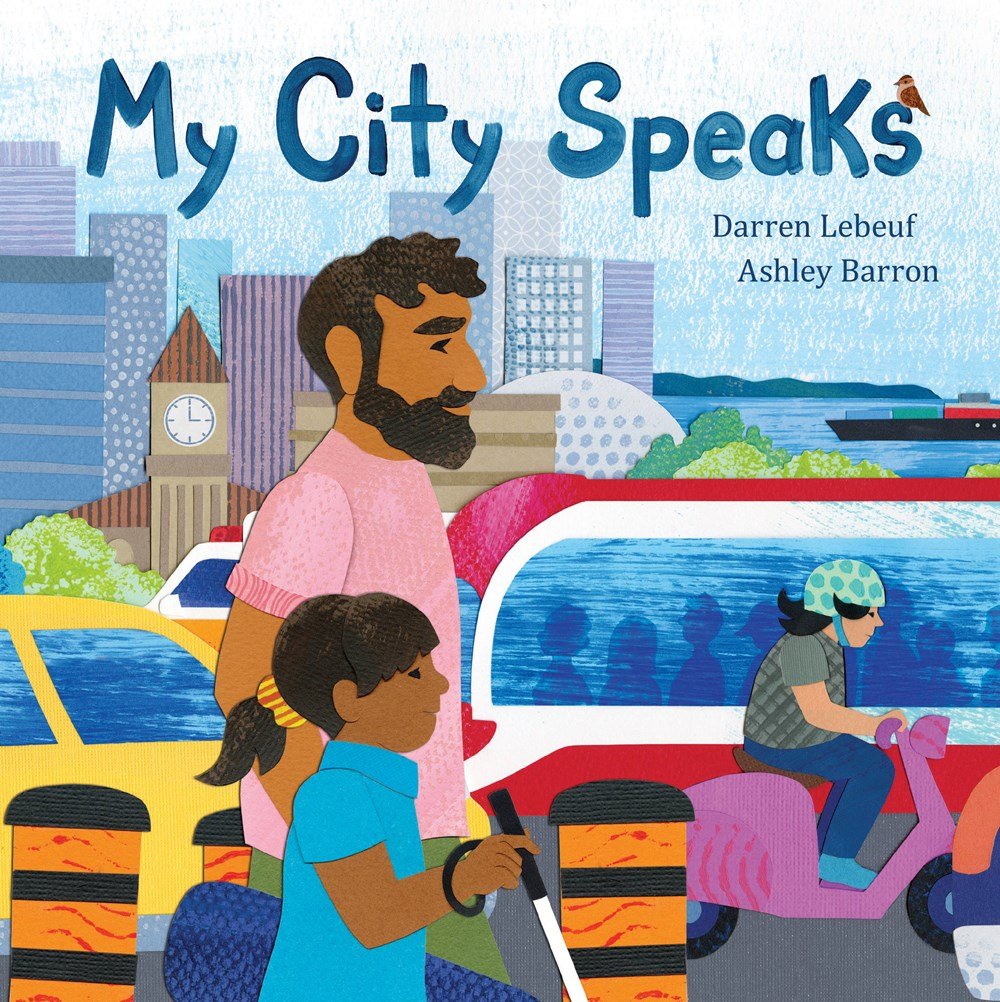My City Speaks
A young girl's exploration of the city she loves. A young girl and her father spend a day in the city, her city, traveling to the places they go together. As they do, the girl, who is visually impaired, describes what she senses in delightfully precise, poetic detail. Her city, she says, “pitters and patters, and drips and drains.” It's both “smelly” and “sweet.” Her city also speaks, as it “dings and dongs and rattles and roars.” And sometimes, maybe even some of the best times, it just listens. A celebration of all there is to appreciate in our surroundings --- just by paying attention!
Darren Lebeuf uses his keen observational skills as an award-winning photographer to poetically capture sensory experiences in this charming ode to city life. The rhythmic, lyrical text makes for an appealing read-aloud. Ashley Barron’s vividly hued cut-paper collage illustrations add compelling visual interest to the text’s descriptions. Though the main character is visually impaired, she travels around the city and enthusiastically enjoys its many offerings, and actively contributes to the lyrical bustle of city life by putting on a violin performance in the park. The author’s use of limited but evocative language can help children develop an aesthetic awareness and can serve as a perfect jumping-off point for children to use their senses to specifically describe, and appreciate, their own surroundings. The story and illustrations were reviewed by a blind sensitivity reader.
A young girl's exploration of the city she loves. A young girl and her father spend a day in the city, her city, traveling to the places they go together. As they do, the girl, who is visually impaired, describes what she senses in delightfully precise, poetic detail. Her city, she says, “pitters and patters, and drips and drains.” It's both “smelly” and “sweet.” Her city also speaks, as it “dings and dongs and rattles and roars.” And sometimes, maybe even some of the best times, it just listens. A celebration of all there is to appreciate in our surroundings --- just by paying attention!
Darren Lebeuf uses his keen observational skills as an award-winning photographer to poetically capture sensory experiences in this charming ode to city life. The rhythmic, lyrical text makes for an appealing read-aloud. Ashley Barron’s vividly hued cut-paper collage illustrations add compelling visual interest to the text’s descriptions. Though the main character is visually impaired, she travels around the city and enthusiastically enjoys its many offerings, and actively contributes to the lyrical bustle of city life by putting on a violin performance in the park. The author’s use of limited but evocative language can help children develop an aesthetic awareness and can serve as a perfect jumping-off point for children to use their senses to specifically describe, and appreciate, their own surroundings. The story and illustrations were reviewed by a blind sensitivity reader.
A young girl's exploration of the city she loves. A young girl and her father spend a day in the city, her city, traveling to the places they go together. As they do, the girl, who is visually impaired, describes what she senses in delightfully precise, poetic detail. Her city, she says, “pitters and patters, and drips and drains.” It's both “smelly” and “sweet.” Her city also speaks, as it “dings and dongs and rattles and roars.” And sometimes, maybe even some of the best times, it just listens. A celebration of all there is to appreciate in our surroundings --- just by paying attention!
Darren Lebeuf uses his keen observational skills as an award-winning photographer to poetically capture sensory experiences in this charming ode to city life. The rhythmic, lyrical text makes for an appealing read-aloud. Ashley Barron’s vividly hued cut-paper collage illustrations add compelling visual interest to the text’s descriptions. Though the main character is visually impaired, she travels around the city and enthusiastically enjoys its many offerings, and actively contributes to the lyrical bustle of city life by putting on a violin performance in the park. The author’s use of limited but evocative language can help children develop an aesthetic awareness and can serve as a perfect jumping-off point for children to use their senses to specifically describe, and appreciate, their own surroundings. The story and illustrations were reviewed by a blind sensitivity reader.

